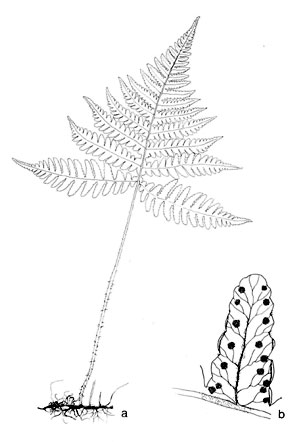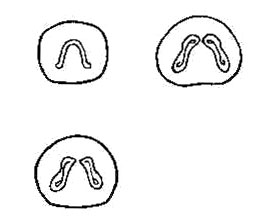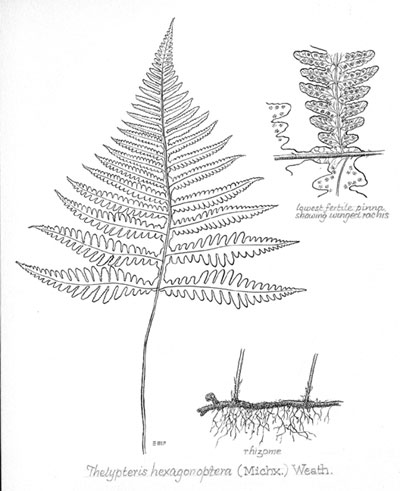|
Hardy Fern Home P. hexagonoptera resources All Ferns � Thelypteridaceae �� Phegopteris
�Other Genera
|
| Phegopteris hexagonoptera | ||
Southern beech fern, broad beech fern | ||
|
Etymology
Hex means six; gona, joint; pterus comes from pteron, the Greek word for wing, thus it is a six-jointed wing.
Description
Rhizome: long-creeping, branching, black, ovate scales.
Frond: 60 cm high by 30 cm wide, deciduous, monomorphic, blade/stipe ratio: less than 1:1. Stipe: straw-colored at base, scales tan, lanceolate, below, and sometimes pointed hairs, vascular bundles: 2, elongate, at 90�, merging or not by the top of the stipe to an open u-shape. Blade: 2-pinnate, though some pinnules are pinnatifid or nearly so at the base, triangular, broadest at base, usually as broad as long, light green, below moderately to densely set hairs along costae and veins, also of yellowish stalked glands on veins and blade tissue. Pinnae: 12 to 15 pair, all connected by wing along rachis; pinnules on lower pinnae, shorter near the rachis, further up, more the same size; costae not grooved, ovate-lanceolate, light tan to shiny brown scales below; margins lobed; veins free, simple or forked. Sori: round, sparse, at the end of a vein and the base of a cleft, indusium: absent, sporangia: tan, maturity: mid to late summer. Culture
Habitat: moist woods, usually in full shade, often in moderately acid soils .
Distribution: eastern North America.
Hardy to -35�C, USDA Zone 3.
Distinctive Characteristics
winged rachis; note that in P. connectilis the pinnae are NOT all connected, but they are here
Synonyms
Polypodium hexagonopterum Michaux Dryopteris hexagonoptera (Michaux) C. Christensen Thelypteris hexagonoptera (Michaux) Nieuwland |
|
|

Phegopteris hexagonoptera. a) frond, winged between pinnae; b)fertile pinnule,�hairs on costa and costule. �Illustration by V. Fulford from Ferns and Fern Allies of Canada, William J. Cody and Donald M. Britton, 1989, � Agriculture Canada, used with permission. |

Phegopteris hexagonoptera. Two elongate, S-shaped bundles at the stipe base, merging or not at the stipe apex. �Drawing from Ferns of Northeastern United States, Farida A. Wiley, 1936. |
